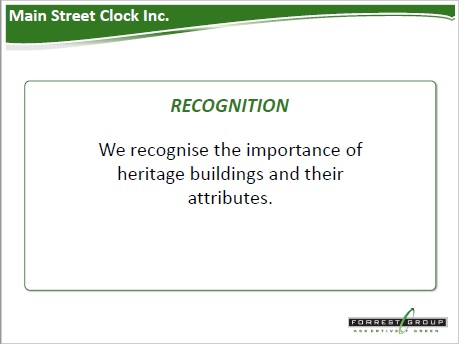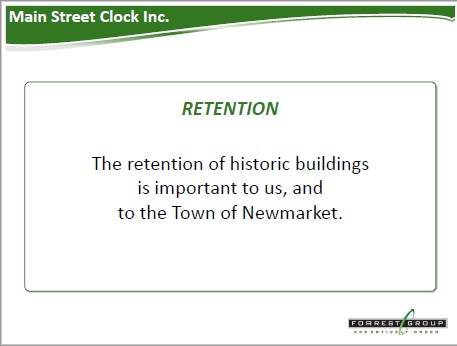The casual demolition of irreplaceable historic commercial buildings - including one dating from the mid 1840s - represents
"good heritage planning"
according to Ira Kagan, the lawyer who will be presenting Bob Forrest's case to the OMB next Wednesday.
So why not allow property owners to demolish if they want to? They can keep the facade, perhaps spruce  it up a bit, and redevelop the site? What's wrong with that?
it up a bit, and redevelop the site? What's wrong with that?
Demolish to Conserve!
In the bizarre world of planning, contaminated as it is by vested interests and biddable lawyers, it doesn't seem at all ridiculous to recommend the demolition of historic buildings in order to save them.
The Town's 2011 Heritage District Plan (replicated word for word in the 2013 By-law) says this about historic buildings (the definition of which includes the historic commercial buildings at 184, 188 and 194 Main Street South that Forrest wants to demolish).
"The Town recognises the importance of four forms of historic buildings in the district - historic landmark buildings, historic commercial buildings, historic houses and the historic registry office - and their heritage attributes."
and for the avoidance of doubt
"The Town supports the retention of historic buildings in the district."
and to underline the point
"Demolition and replacement of historic buildings needs to be avoided since the conservation of historic buildings is essential to maintaining the district's authentic historic character and revitalising the district."
Competing Interests
Forrest's Heritage Impact Assessment, prepared for him by Goldsmith Borgal in February 2016, said a review of (previous) plans for the old downtown
"reveals numerous competing interests that ultimately must be weighed by the Town Council. It is Town policy to revitalise Lower Main Street South while preserving its historic character. However, throughout these various plans, the realistic ability to achieve these two goals simultaneously has not been outlined/illustrated."
Goldsmith Borgal conclude:
"...the proposed development, while not meeting the Heritage Conservation District Plan in terms of height restrictions, could be mitigated in order to allow the Town to meet a number of other planning goals in the Historic Downtown Core. This Heritage Impact Assessment includes examples of how architectural design can further enhance the compatibility of new construction in Heritage Conservation Districts."
So Goldsmith Borgal's strategy is to "mitigate" the impact of the Clock Tower development rather than rule it out completely despite the fact that historic buildings will disappear forever. Once they are gone they are gone. 
The Town's Planning Department did not tell Goldsmith Borgal about the manipulation of the Floor Space Index (and neither had they told ERA Architects) despite the fact that the FSI feeds directly through to the built form.
Like the rest of us they were kept in the dark. That said, I might have expected them to ask the question: How come we are looking at such a huge structure in a Heritage Conservation District?
One of the oldest buildings on Main Street. No point keeping that!
In Goldsmith Borgal's review of the buildings to be demolished there is this pen portrait of 184 Main Street South:
"This two storey frame structure is the oldest extant building on the block, and perhaps one of the oldest buildings on Main Street South. Dating to the early nineteenth century (likely c1840), it may be the building referenced in an early drawing of the street as the Smith & Emprey General Store. Smith and Emprey was established in 1837 and was located immediately north of the North American Hotel. The building at 184 Main Street South is also represented on the 1862 plan of the Village on lot 19. Charles Hargrave Simpson, whose wife, Anne Mary Simpson, was Ontario's first woman druggist, once owned the building. Simpson operated an apothecary from 1886 to 1914."
This is one of the buildings to be casually demolished in the name of:
"good heritage planning".
The Town commissioned ERA Architects to peer review the work of Goldsmith Borgal.
The peer reviewer and its obligations to the Town
In November 2013 the Town awarded a “peer review” contract to ERA Architects of Toronto. They would be responsible for peer reviewing any Heritage Impact Assessment for 180-194 Main Street South. The terms of the Town's contract with ERA Architects specified:
"The Peer review will evaluate the assessments provided for heritage impact assessment. This review will include, but is not limited to, addressing inconsistencies, factual errors, discrepancies, inappropriate conservation advice not consistent with recognized standards (see below), omissions and misrepresentations.
It is expected that the preferred protective and mitigative measures will be consistent with the Lower Main Street South Heritage Conservation District Plan and recognized standards for heritage conservation..." (my underlining)
ERA Architects prepared two peer reviews (on 22 July 2014 and 4 May 2016) and the central question of the demolition of historic commercial buildings was not addressed head-on by either.
ERA understood the developer was intending to adaptively re-use the Old Post Office Building and "where possible" incorporate the facades of the 19th century commercial buildings at 184, 188 and 194 Main Street South. (190 Main Street South is a late twentieth century commercial infill with no architectural or historic merit.)
Their recommendations included this one to:
"Clarify the conservation strategy by describing the intended approach to each building being conserved."
The honest answer is to say they are being conserved through demolition with the facades being retained if possible.
Ludicrously, we shall only be told about the “conservation strategy” if the development gets the go-ahead. It will then be addressed at site plan approval stage. I wonder what the owner of the restaurant/pub at 196 Main Street South thinks about that. He shares a roof and a floor with 194 which is earmarked for demolition. 194-196 are two halves of the same building. 
How do you square demolition with the HCD Plan?
There are concerns that ERA Architects may not have fulfilled the terms of their contract with the Town which obliged them, when preparing their peer review, to take into account the Town's Heritage Conservation Plan which specifically ruled out the demolition of historic commercial properties. I wrote to the Town's Chief Administrative Officer, Bob Shelton, who replied on 20 May 2016:
"I have discussed the review process with staff and advise that your comments and various points will be provided to Planning staff for their consideration as part of the review of the peer review report."
I have asked for sight of the review of the peer review but I am still waiting. These days it's radio silence.
Forrest Fumes
In his intemperate letter of 28 November 2016 to councillors, Bob Forrest railed against the Town's decision to reject his Clock Tower development by calling in aid the heritage professionals:
"the two heritage experts have brought monumental experience and expertise to support staff... that experts of this caliber (sic) should be arbitrarily rebuffed without consultation or explanation is disappointing, surprising and, in the end, shocking."
When Forrest started out on his calamitous Clock Tower project he wanted to demolish the historic buildings at 184, 188 and 194 in their entirety. But his slideshow presentation to the Statutory Public Meeting on 9 May 2016 tells us he now loves heritage - and so does the Town.
Now that we've got that boring and tedious conservation stuff out of the way...
bring up the wrecking balls and let's get started!
This email address is being protected from spambots. You need JavaScript enabled to view it.
